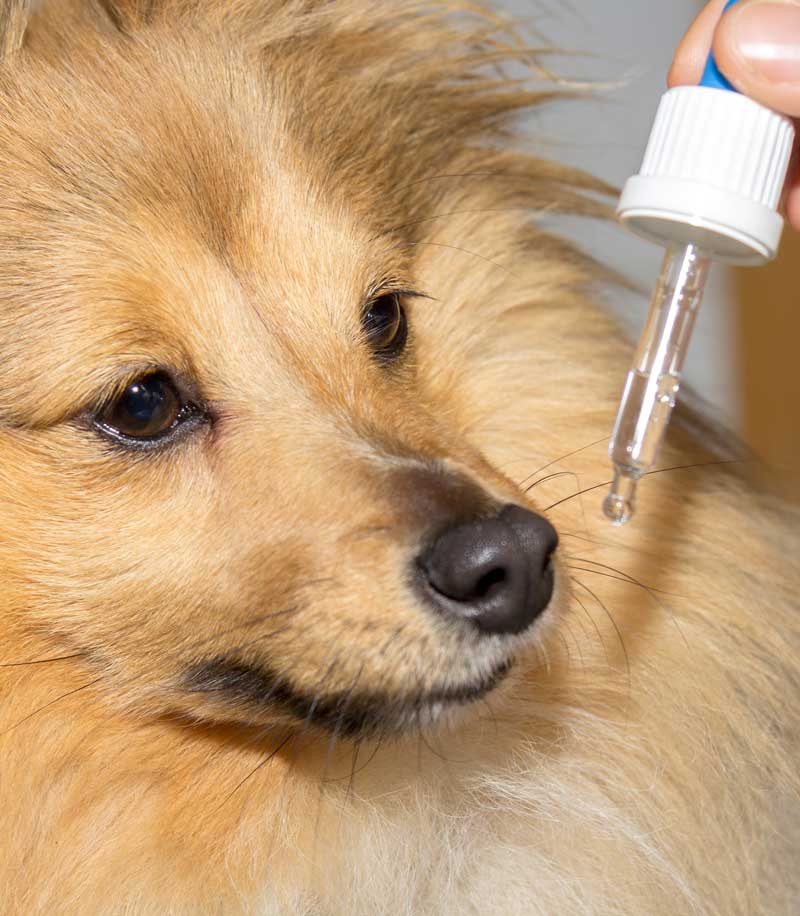It’s an all-too-common reality for many dogs and their owners: Seizures.
Whether caused by epilepsy, liver or kidney disease, stroke or brain cancer, both dogs and humans can suffer from seizures. These epileptic episodes can happen at any time, and when they do your dog is at risk of physical, neurological and emotional trauma.
How can you help your pet when a seizure strikes? Understanding the what, why and how seizures affect your canine is the first crucial step to prevention and treatment
Canine Seizures & Epilepsy
Types of Seizures in Dogs
Epileptic episodes can happen at any time, but the severity and frequency can depend on your dog’s breed, genetics, age and neurological health.
Grand Mal Seizures: the most common, or general type of seizures in dogs, Grand mal seizures affect the electrical activity in the entire brain. Consequently, your dog can start convulsing, become disoriented and as a result lose consciousness. Seizures of this variation are also known as ‘Generalized’ seizures.
Duration: A few seconds – > 1-2 minutes
Focal Seizures: occur when electrical activity in a specific part of the brain is affected. This kind of epileptic episodes can cause sporadic twitching, irregular movement or unusual behavior in one side or limb of the body. Also known as ‘Partial Seizures’, Focal seizures can lead to Grand Mal seizures – this is referred to as ‘secondary generalization’.
Duration: A few seconds – < 1 minute
Cluster Seizures: associated with larger breeds of dogs, Cluster seizures are multiple epileptic episodes that happen within a 24-hour period. These groups of seizures can be an indication of epilepsy, or increasingly severe structural brain lesions affecting your dog’s electrical brain activity.
Idiopathic Epilepsy: believed to be inherited/genetic, Idiopathic epilepsy often occurs during fluctuations in brain activity – i.e. during meals, physical activity or falling asleep/waking from sleep. Idiopathic seizures can be caused by brain lesions – an abnormal area of tissue, inside or outside the body – that can lead to more severe and frequent seizures, if left untreated.
Common Causes of Seizures in Dogs:
Although seizures are very common in most breeds, younger dogs (< 2 years of age) are more prone to serious epileptic episodes.
Before we look at dog seizures treatments lets have a look at what a seizure is and how they occur. A seizure is when an uncontrolled electrical activity in the brain occurs, seizures can range from minor such as a twitching of the face or leg to more serious where a dog can begin to convulse, lose consciousness, has uncontrolled muscle movements or loses bowel and/or bladder control. There are different types of seizures a dog can experience, most commonly is the grand mal seizure. The grand mal seizure affects both the right and left side of the brain and the entire body. What happens is that both cerebral hemispheres become activated simultaneously which results in things like loss of consciousness, rhythmic contraction of muscles like paddling, jerking of limbs and chewing jaw movements. Some dogs may also salivate, urinate or defecate. A focal seizure also known as a partial seizure is a harder seizure to identify within dogs. A group of neurons begin firing in one part of the cerebrum, while not spreading to other areas of the brain. There are two types of focal seizures: Simple: This is a result from firing neurons in the motor area of a cerebral hemisphere which brings on involuntary movements of the limbs such as jerking or repetitive facial muscle movements with consciousness potentially being impaired. Complex: Complex partial seizures are much harder for dog owners and veterinarians to recognize because they manifest as a behavioral abnormality. Consciousness becomes impaired and the dog can show signs of motionless staring, aggressive and display hallucinatory behaviour such as fly biting. This type of seizure targets the limbic system or temporal lobe of the cerebrum. A psychomotor seizure is when a dog displays strange behavior over a spurt of a couple of minutes, the dog may also begin to attack an imaginary object. It can be difficult to tell psychomotor seizures from strange behavior, but a dog that has them will always do the same thing every time he has a seizure.
Symptoms of a seizure in dogs
Dogs experience three stages when they have a seizure, Aura, Ictus and Postictal phase. Aura is the few minutes before a seizure, a period of strange or alerted behavior from the dog. This can be difficult to predict but the dog may hide, appear anxious or seek attention prior to the seizure. Ictus, this is the actual seizure the dog experiences, usually lasting anywhere from a few seconds to two minutes. Postictal phase is what comes after the seizure, it is when the dog becomes disorientated lasting up to a few minutes to a few hours depending on the dog. Other common sings of postictal phase seizures are behavior changes, long sleeps, confusion, transient blindness or aggressive eating. Understanding your dog’s genetic predispositions and medical history can be of great importance when determining if your dog is susceptible to seizures. The most common causes for seizures in dogs:
- Brain Cancer
- Encephalitis
- Head Injury
- Stroke
- Ingesting Toxic Substance/Poisons
- Liver Disease
- Kidney Disease
- Canine Diabetes
- Low/High Blood Sugar
- Anemia
Seizures are often preceded by moments of disorientation, panting, confusion and stress.
Senior dogs are most commonly at risk of suffering from canine seizures. Seizures in senior dogs can occur due to a variety of disorders such as epilepsy, but seizures can also be a symptom of old age and deteriorating health. The most prominent signs that your dog is experiencing seizures are:
- Acting strange, changing behavior (become confused, anxious, seek your attention with urgency)
- Losing bodily functions (fall down, be unable to move, begin to twitch)
- Seizing up (become stiff and immobile, jaw will clench shut, drool or froth profusely)
- Losing consciousness, coherence (thrash their limbs, defecate/urinate, whimper or yelp)
Some focal seizures – that affect only an isolated part of the brain, and therefore particular parts of the body – can seem minor and be altogether missed. Facial twitching, limb-stiffness and excessive panting/salivation can resemble a “Stroke”, but paying close attention to your dog’s behavior can help to determine that he/she is suffering a seizure.
Seizures in Senior Dogs
How can you help during a Seizure?
If your dog’s seizures last longer than 3-5 minutes, you should immediately call your veterinarian and follow their instructions. The longer seizures are in duration, the more risk your dog has of incurring serious brain injury.
Treatment and Prevention for Seizures in Dogs
CBD oil for seizures in dogs have grown in popularity in recent years. CBD for seizure control in dogs & treatment and prevention isn’t just an average natural remedy – many dogs and dog owners are experiencing life changing effects from CBD treatments.
FAQ’s
What do you do if your dog is having a seizure?
First of all, stay calm and in control. Try to clear space around your dog and ensure they’re not in a vulnerable position (their spasmodic thrashing may cause you harm or harm to themselves if objects are in their immediate area). If you can, take a video of the epileptic episode for use later at the veterinary clinic. It is also very important for you to try to soothe or comfort your dog during and after a seizure – if their seizure is quite violent and you cannot safely hold or pet them, try to use soothing reassurance or talk calmly to your pet.
What dog breeds are prone to seizures?
Any dog breed can suffer from chronic seizures, but some canine breeds are known to have seizures more often than others. Beagles, Keeshonds, Belgian Tervurens, Labrador & Golden Retrievers, Shetland Sheepdogs, Bernese Mountain Dogs and Saint Bernards have shown genetic predisposition to seizures.
Should I take my dog to the vet after a seizure?
Yes, always try to get your dog to the vet as soon as possible after a seizure. It is a good idea to call ahead first, and always follow your vet’s instructions for post-seizure care.
How does a dog behave after a seizure?
After experiencing a seizure, your dog will likely be very disoriented and perhaps even frightened or aggressive. Some canines exhibit signs of dehydration, nausea, lethargy and erratic behavior like growling. These symptoms can last mere minutes or even hours after a seizure, so make sure you pay close attention to your dog and keep them calm, in a safe place until your vet instructs you that it’s okay.
What is the life expectancy of a dog with epilepsy?
Life expectancy will vary greatly on a number of factors – your dog’s age, health, breed, diet, etc – but many dogs can continue to live long & healthy lives even if they suffer from epilepsy. The more care & attention you can devote to preventing seizures, treating them when they do occur and helping your dog to feel safe & happy after a seizure will play major roles in your canine’s life expectancy.









